Recycling Symbols
To make recycling and disposing of waste easier, many manufacturers now include specific labels on their packaging. This means that whenever a consumer picks up a product, they know exactly what to do with it when they’re finished. In fact, there are several rules and regulations in place that mean these materials must be included in the packaging.
However, while some symbols are very clear in their instructions, others are used less frequently and may be a little harder to understand. That’s where this handy guide comes in!
Recycling Logos
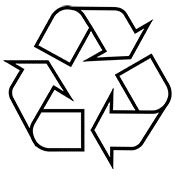
Mobius loop
What to do when you see the Mobius loop logo?
The triangle on its own means the product can be recycled. Typically, this means that the item can be disposed of with your general recycling. Sometimes, a variation of this logo exists with a percentage featured in the middle of the loop. This gives you an indication about how much of the product can be recycled.
What are examples of waste with the Mobius loop logo on?
As this is the most common logo displayed on recyclable products, you will likely come across it several times in a single day. This could include:
- Plastic waste (Bottles & containers)
- Paper waste (Magazines)
- Glass waste (Bottles)
How much of this waste is produced?
We produce large volumes of recyclable waste on a daily basis. In the UK alone, we produce around 12 million tonnes of recycling waste each year – which is just under 50% of our overall waste output. However, too often recyclable waste finds its way into general waste collections, meaning it’s disposed of incorrectly. In fact, a recent report by National Geographic found that 91% of plastic waste is not sent to a recycling facility.
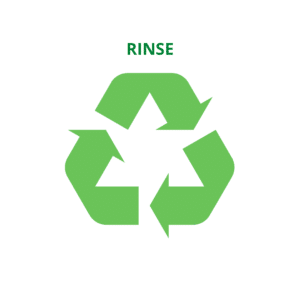
Recycle and Rinse symbol
What to do when you see the recycle and rinse symbol
This symbol means that the item can be recycled, but it must be rinsed/cleaned before you throw it away. This is often used on food packaging and reduces the chance of your waste being contaminated or attracting vermin.
What are examples of waste with the recycle and rinse symbol on?
There are various types of products that feature this symbol. This includes:
- Glass jars (Food)
- Metal (Cans, tins)
- Plastic (Shampoo bottles, food containers)
How much of this waste is produced?
Failure to rinse products before recycling them could mean that your waste is classified as contaminated. This means it may be impossible to recycle. Around 15% of dry mixed recycling bins are contaminated in this manner, which significantly reduces the material that can be recycled.
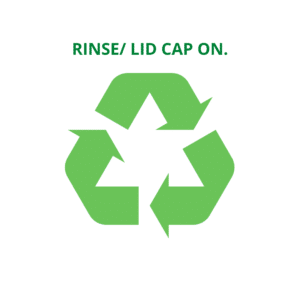
Recycle, Rinse with Lid Cap on symbol
What to do when you see the recycle, rinse with lid cap on symbol
Products with this symbol can be recycled. However, you must ensure that they are rinsed and that their lid/cap is tightly secured. This is because small bottle caps can interfere with the recycling process. Furthermore, if they are thrown away in general waste, they could serve as a choking hazard.
What are examples of waste with the recycle, rinse with lid cap on symbol?
A variation of this symbol will appear on any products with small caps/lids. This could include:
- Plastic Water Bottles
- Milk Cartons/Containers
How much of this waste is produced?
As this kind of waste mainly includes bottles and drinks containers, thousands upon thousands of them are thrown away every day. For example, in the UK alone, around 35 million plastic bottles are used every 24 hours- but the vast majority of them are not properly recycled.
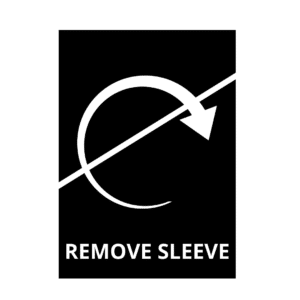
Don’t Recycle and Remove Sleeve symbol
What to do when you see the don’t recycle and remove sleeve symbol
Unfortunately, not all packaging waste can be recycled. When you see this product, it may be that everything but the sleeve can be recycled – so ensure you take the time to remove it fully.
What are examples of waste with the don’t recycle and remove sleeve symbol on?
There are various products that feature this symbol. This includes:
- Packaging Waste
- Product labels
How much of this waste is produced?
Product packaging, such as sleeves, are used to help promote brand and inform as to what the products we buy are made from – whether they be food items or commercial products. However, they are often difficult to recycle, and as a result, packaging waste is a key contributor to crowded landfills. In fact, plastic packaging makes up for 70% of the UK packaging waste.
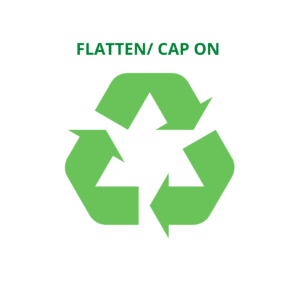
Flatten with Cap on recycle symbol
What to do when you see the flatten with cap on recycling symbol
When this symbol is featured on a product, it means that before it is stored in the recycling bin you must flatten the item and ensure the cap is still on. This can help you maximise the space in your bins.
What are examples of waste with the flatten with cap on recycle symbol on?
Numerous products will feature this symbol. This could include:
- Plastic Bottles
- Milk Cartons
- Fabric Softener containers
How much of this waste is produced?
Keeping the cap on your bottles when recycling reduces the chance of the lid getting lost during the recycling process. For example, sometimes, the lids will fall through holes in machinery. Taking the proper steps to recycle this kind of product can reduce the damage that single-use plastics have on the environment. Currently, less than 10% of single-use products are recycled – despite millions of them being used daily.
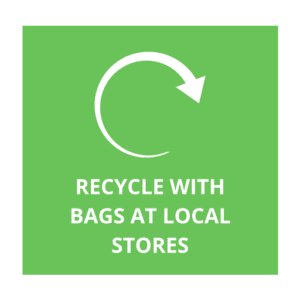
Recycle at a large supermarket and don’t recycle at home recycle symbol
What to do when you see the recycle at a large supermarket symbol
This symbol mainly relates to your household waste, and it means that the materials cannot be recycled through kerbside pick up. This is because the items may be slightly harder to recycle.
What are examples of waste with the recycle at a large supermarket with bags symbol on?
Various items can be recycled at your local supermarket. This includes:
- Plastic cereal bags
- Glossy magazines
- Plastic packaging waste
- Bread bags
- Batteries
How much of this waste is produced?
It is hard to monitor the amount of waste produced in this category, as it covers a wide range of products. However, since their implementation, supermarket recycling points have had a positive impact on the environment by ensuring products that would otherwise be thrown away are now taken to the appropriate treatment facilities.
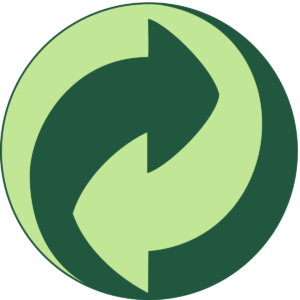
The Green Dot recycle symbol
What to do when you see the green dot recycle symbol
Whenever a green dot appears on packaging, it means that the company that produces the product contributes money to recycling schemes. Though it appears to suggest that a product is recyclable, this is not always the case.
What are examples of waste with the green dot recycling symbol on?
This symbol features prominently on a variety of different products, namely in relation to packaging. This could include:
- Food Packaging
- Drink Packaging
How much of this waste is produced?
A large proportion of the waste we produce is non-recyclable. For example, in 2018 the UK produced around 37 million tonnes of waste, of which a very small fraction was sent to the appropriate recycling centres. Failing to source recyclable products, or disposing of them correctly, has an increasingly negative impact upon the environment.
How can you reduce the amount of recyclable waste you produce?
There are various steps you can take to reduce the amount of waste you produce – both within your business and household.
Perhaps the most important step you can take to achieve this goal is to quite simply educate yourself. Before purchasing a product, do your research so that you know about the potential implications it can have on the environment.
Following this, you need to be prepared to implement real change. For example, you can change the way in which you shop. The most straightforward way to reduce this kind of waste is by making smarter, more environmentally friendly decisions when it comes to sourcing products and materials for your company or your home. For example, this could mean that you stop purchasing single use plastics in favor of materials that last longer and don’t need to be disposed of right away. In addition, you should also ensure that you buy the right amount of materials and supplies you need – so that nothing is going to waste.
You can also reduce the amount of waste you produce as a business by reusing or repurposing materials as much as possible. Put together a company recycling policy – and ensure that employees stick to it. Finally, you can reduce the amount of waste you use or dispose of incorrectly by working with a licensed waste disposal company – who can ensure that all waste is safely and securely disposed of.
Plastic Resin Recycle Codes
There are several different types of plastic, and some facilities will require the plastic to be separated prior to collection. This is due to the fact that each type of plastic will need to be disposed of in a slightly different way.
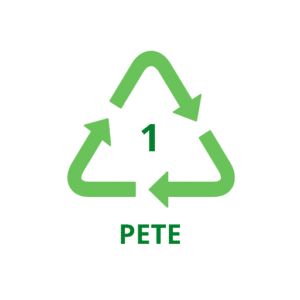
Code 1: PETE (Polyethylene Terephthalate)
PETE plastic (or PET). is the most widely used form of plastic. In fact, around 70% of all plastic bottles and containers in the United Kingdom are made from PETE. Thankfully, it is widely recycled.
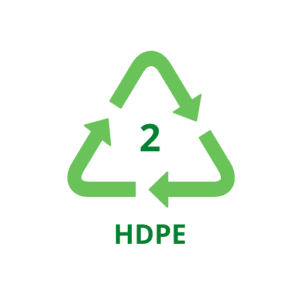
Code 2: HDPE (High-Density Polyethylene)
HDPE was typically used by those who work within the construction industry, as it was used to manufacture pipes. However, it is now also used to create containers such as milk cartons and cleaning product bottles. It is widely recycled.
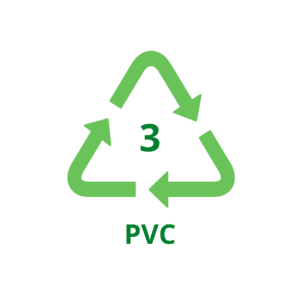
Code 3: PVC (High-Density Polyethylene)
PVC, like HDPE, is typically used within the construction industry – to create products such as door and window frames. It is widely recycled.
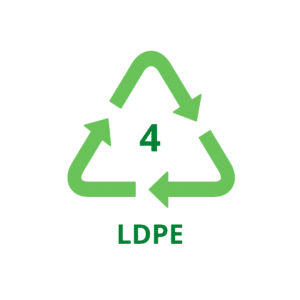
Code 4: LDPE (Low-Density Polyethylene)
LDPE is often used to create plastic carrier bags and bin bags. Unfortunately, it is the most typically discarded form of plastic – with the world using around 500 million plastic bags each year – of which a small portion are recycled. Thankfully, there are now initiatives in place to recycle the products.
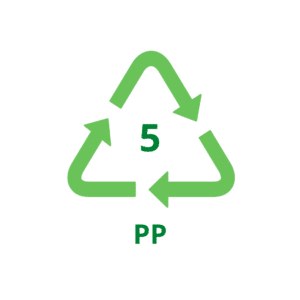
Code 5: PP (Polypropylene)
PP plastics are often used to create packaging, such as plastic tubs and containers, or drinks cartons. It can also be used to create furniture. This type of plastic can be recycled.
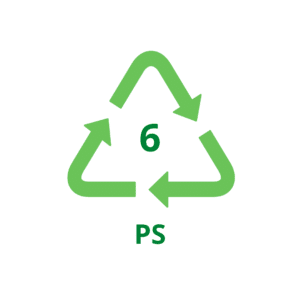
Code 6: PS (Polystyrene)
Polystyrene is sometimes referred to as styrofoam and is used predominantly within packaging, to protect fragile items from getting damaged. Polystyrene is not widely recycled and can pose a real threat to the environment.
Learn about polystyrene recycling
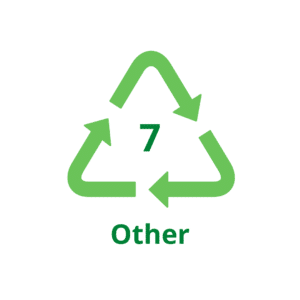
Code 7: Other.
This section holds any type of plastic that does not fall within any of the above categories. It includes items such as fibreglass and acrylic plastic. Whether or not the items can be recycled varies.
Other Important Recycling Symbols
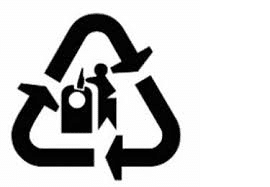
Glass recycling symbol
This symbol is added to packaging to remind consumers that the glass can be recycled after use. It is recyclable, even if the materials contained within it aren’t.
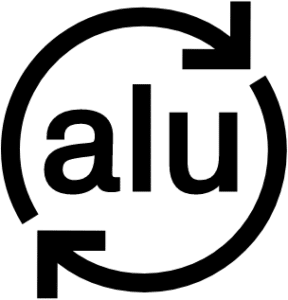
Aluminium recycling symbol
This symbol informs the user that the product is made from recyclable aluminium. For example, this is typically featured on tinfoil packaging.
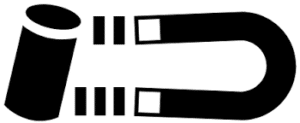
Steel recycling symbol
This symbol means that the product is made from steel, which can be recycled. This could for example be found on steel cans.
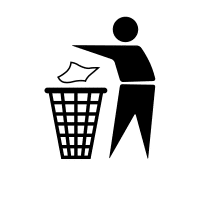
Tidy Man recycling symbol
This symbol was introduced as part of a UK initiative to remove waste from the streets. It is known as the ‘Keep Britain Tidy’ scheme, and the inclusion of the Tidy Man on packaging encourages users to safely dispose of the product after use.
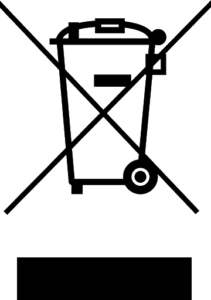
Waste electricals recycling symbol
This symbol features prominently on electrical products, such as WEEE Waste – and signifies that they cannot be thrown away alongside your commercial waste.
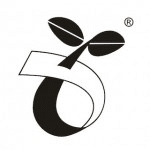
Compostable waste recycling symbol
This symbol means that the products or packaging can be composted. This could include food waste or garden waste, but also certain types of packaging – which you can dispose of via composting. On some occasions, a slight variation of this logo will inform you whether or not this can be composted at home or at a specialist facility.
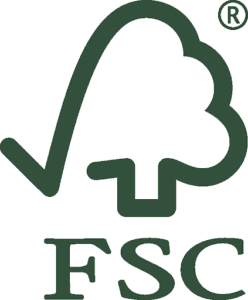
Symbol: Forest Stewardship Council
This symbol means that the product has been approved by the Forest Stewardship Council, meaning that it is produced in a way that is deemed environmentally friendly. It typically features on products made from paper, cardboard and wood.
It is important, as a business owner and consumer – that you take the time to fully understand what each of these symbols means. This can help you improve your recycling habits, working towards a better and brighter future.
In fact, there are many benefits of recycling at work. It means that you are cooperating with government-mandated regulations and can demonstrate to your customers that you are committed to protecting the planet. By implementing a strong recycling scheme at work you can also save your company a great deal of money while helping to reduce pollution.
If you’re looking for help with your waste management and disposal, please do not hesitate to get in touch. At Business Waste, we have years of industry experience, which means we are in a prime position to tackle any of your waste management and disposal needs; working to put together a plan that suits you.
Have your waste collected
Get a fast FREE quote for your waste collection 0800 211 83 90
- Free quote within 1 hr
- Any type of waste
- FREE bins and delivery
- We cover all of the UK